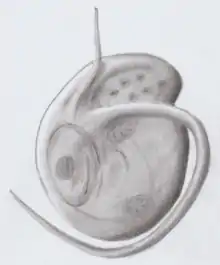Ancyromonas
Ancyromonas is a basal Eukaryote. It is a flagellate.[1]
| Ancyromonas | |
|---|---|
 | |
| Ancyromonas sp. | |
| Scientific classification | |
| Domain: | Eukaryota |
| Phylum: | Loukozoa |
| Genus: | Ancyromonas Kent 1880 |
| Type species | |
| Ancyromonas sigmoides Kent, 1880 | |
| Species | |
| |
It includes the species Ancyromonas sigmoides.[2]
Planomonas has been described as a junior synonym of Ancyromonas.[3] They appear more basal than Malawimonas, placing them in Loukouzoa, possibly as stem podiates, and depending on the placement of the root position of the Eukaryotes.[4][5]
References
- Scheckenbach F, Wylezich C, Mylnikov AP, Weitere M, Arndt H (October 2006). "Molecular Comparisons of Freshwater and Marine Isolates of the Same Morphospecies of Heterotrophic Flagellates". Appl. Environ. Microbiol. 72 (10): 6638–43. doi:10.1128/AEM.02547-05. PMC 1610283. PMID 17021215.
- Cavalier-Smith T, Chao EE, Stechmann A, Oates B, Nikolaev S (October 2008). "Planomonadida ord. nov. (Apusozoa): ultrastructural affinity with Micronuclearia podoventralis and deep divergences within Planomonas gen. nov". Protist. 159 (4): 535–62. doi:10.1016/j.protis.2008.06.002. PMID 18723395.
- Heiss AA, Walker G, Simpson AG (May 2010). "Clarifying the taxonomic identity of a phylogenetically important group of eukaryotes: Planomonas is a junior synonym of Ancyromonas". J. Eukaryot. Microbiol. 57 (3): 285–93. doi:10.1111/j.1550-7408.2010.00477.x. PMID 20384907.
- Brown, Matthew W.; Heiss, Aaron; Kamikawa, Ryoma; Inagaki, Yuji; Yabuki, Akinori; Tice, Alexander K.; Shiratori, Takashi; Ishida, Ken; Hashimoto, Tetsuo (2017-12-03). "Phylogenomics places orphan protistan lineages in a novel eukaryotic super-group". Genome Biol Evol. 10. doi:10.1093/gbe/evy014. PMC 5793813. PMID 29360967.
- Torruella, Guifré; Mendoza, Alex de; Grau-Bové, Xavier; Antó, Meritxell; Chaplin, Mark A.; Campo, Javier del; Eme, Laura; Pérez-Cordón, Gregorio; Whipps, Christopher M. (2015). "Phylogenomics Reveals Convergent Evolution of Lifestyles in Close Relatives of Animals and Fungi". Current Biology. 25 (18): 2404–2410. doi:10.1016/j.cub.2015.07.053. PMID 26365255.
This article is issued from Wikipedia. The text is licensed under Creative Commons - Attribution - Sharealike. Additional terms may apply for the media files.